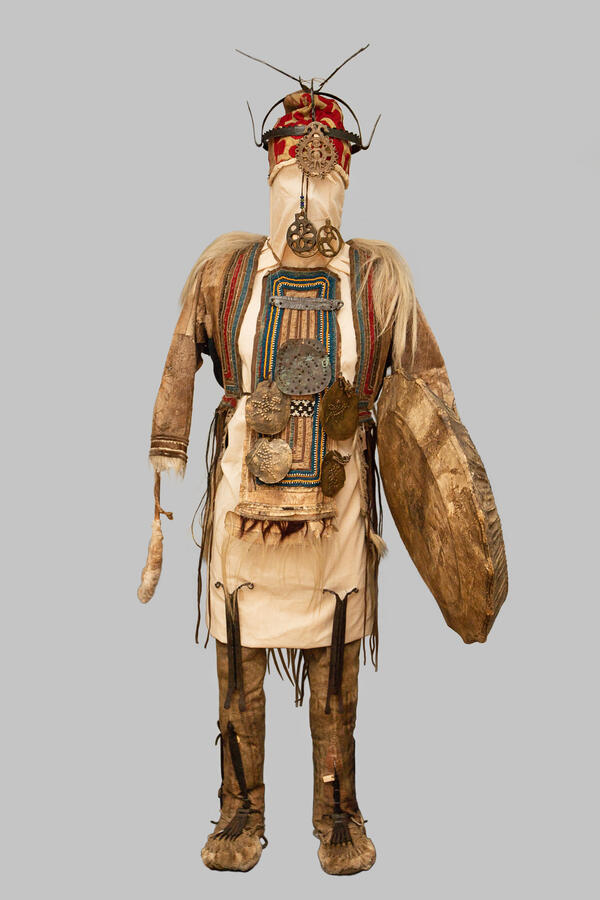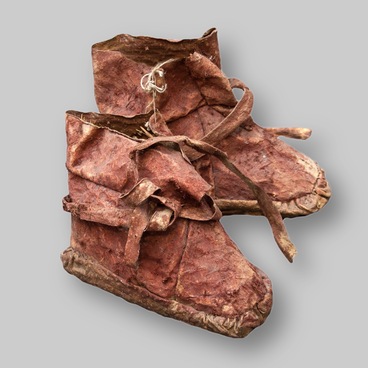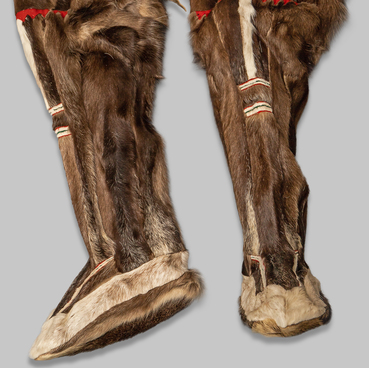The collection of the Tobolsk Provincial Museum contains a fur shamanic parka that recreates the image of a bird. This parka was an individual cult item for the shaman similarly to the tambourine and allowed for performing rituals and travelling between worlds. This copy was sewn by hand with tendon threads using the technique of cross-linking mosaic when many small parts were assembled into one. The hem of the parka was decorated with a long fringe of white and brown goat hair, and the back was decorated with long tassels of straps and horse hair.
A complete set of museum’s shamanic costume consists of a bib, parka, shoes, headdress, dart, and special gloves. It is complex in its design. The costume has images of spirits of all spheres. Helping spirits serving as the ancestors’ protectors were placed on the costume. These are metal figures, both anthropomorphic and zoomorphic, a headdress in the form of a crown with a stylized image of deer horns, a swan, or a crane. All of them had a symbolic meaning and modeled the universe of a particular shaman. Previously, not stylized, but real deer antlers were attached to shamanic hats.
Shamanic clothing of the same peoples existed in different versions. But, despite all the external diversity, shamanic costumes had the same meaning. They recreated the image of an animal or a bird. The shamanic bib of the Selkups often symbolized the breast of a bird. According to researcher Viktor Vasilyev, ‘the entire costume as a whole seems to represent the skin of a bird. By wearing it, the shaman gets the opportunity to fly wherever he wants…’.
Good spirits inhabited the earth and the air. Some of them had the ability to penetrate under ground and water, or helped with treatment and in crafts. Evil spirits lived in the underground world bringing disease, poverty, failure, and unhappiness. Spirits in the form of birds were assigned the role of scouts helping the shaman travel. They connected them with the heavenly world. The spirit of the eagle performed protective functions in relation to the sun, sky, and earth. Shamans turned to them for help only in exceptional cases. The eagle was always paired with a swan.
The swan is the sun bird and the spirit of good. It was sacrificed in order to appease the spirits of the disease when a member of the shaman’s family or the shaman himself was very seriously ill. The shaman was accompanied by a loon when traveling to other worlds. It connected shamans with the water element, helped overcome water obstacles, find and destroy evil spirits in the underwater world. The figure of a loon was used by the shaman in healing. The bird’s beak was directed to the affected area. It was believed that it pulls out and destroys the spirits of the disease.
A complete set of museum’s shamanic costume consists of a bib, parka, shoes, headdress, dart, and special gloves. It is complex in its design. The costume has images of spirits of all spheres. Helping spirits serving as the ancestors’ protectors were placed on the costume. These are metal figures, both anthropomorphic and zoomorphic, a headdress in the form of a crown with a stylized image of deer horns, a swan, or a crane. All of them had a symbolic meaning and modeled the universe of a particular shaman. Previously, not stylized, but real deer antlers were attached to shamanic hats.
Shamanic clothing of the same peoples existed in different versions. But, despite all the external diversity, shamanic costumes had the same meaning. They recreated the image of an animal or a bird. The shamanic bib of the Selkups often symbolized the breast of a bird. According to researcher Viktor Vasilyev, ‘the entire costume as a whole seems to represent the skin of a bird. By wearing it, the shaman gets the opportunity to fly wherever he wants…’.
Good spirits inhabited the earth and the air. Some of them had the ability to penetrate under ground and water, or helped with treatment and in crafts. Evil spirits lived in the underground world bringing disease, poverty, failure, and unhappiness. Spirits in the form of birds were assigned the role of scouts helping the shaman travel. They connected them with the heavenly world. The spirit of the eagle performed protective functions in relation to the sun, sky, and earth. Shamans turned to them for help only in exceptional cases. The eagle was always paired with a swan.
The swan is the sun bird and the spirit of good. It was sacrificed in order to appease the spirits of the disease when a member of the shaman’s family or the shaman himself was very seriously ill. The shaman was accompanied by a loon when traveling to other worlds. It connected shamans with the water element, helped overcome water obstacles, find and destroy evil spirits in the underwater world. The figure of a loon was used by the shaman in healing. The bird’s beak was directed to the affected area. It was believed that it pulls out and destroys the spirits of the disease.



